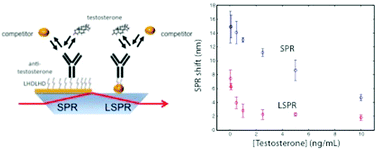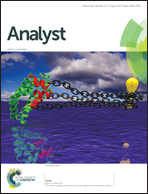Plasmonic sensors for the competitive detection of testosterone†
Abstract
The ability to detect small molecules in a rapid and sensitive manner is of great importance in the field of clinical chemistry, and the advancement of novel biosensors is key to realising point-of-care analysis for essential targets. Testosterone is an example of such a small molecule, the detection of which is important in both clinical analysis, and in the sporting industry to prevent doping. As such, a portable, rapid and sensitive test for testosterone would be of great use across a variety of analytical fields. Here we report on a novel method of testosterone analysis, based on a competitive inhibition assay utilising functionalized gold nanoparticles. Two sensing platforms are directly compared for the detection of testosterone based on both classical SPR and LSPR. We provide an in-depth discussion on the optimum surface chemistries needed to create a stable detection conjugate before successfully detecting testosterone using our newly developed portable 4-channel SPR instrument. We provide the first detailed study into the comparison of SPR and LSPR for the analysis of a small molecule, and provide a simple and effective method of testosterone detection that could potentially be extended to a variety of different analytes.


 Please wait while we load your content...
Please wait while we load your content...